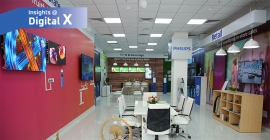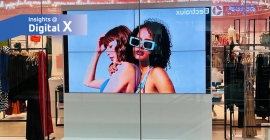‘Measurability has always been Achilles heel of OOH industry’
By Aayush Mohanan - September 13, 2023
As the OOH industry gains momentum, solution providers aim to fix the missing piece of the puzzle – measurability of the medium. Magesh Poondi, CEO, ReLU AI Systems gives us an idea of how the adtech revolution is coming about in audience metrics in an interview with Aayush Mohanan.
Could you explain how the OOH metrics platforms Roadstar and Telescope developed by your firm ReLU AI System are ideal for media owners and specialist agencies in the Indian market?
Roadstar is an audience measurement platform that is built specifically for OOH media. It’s an audience measurement platform that provides data not only on the number of people that have gone past a certain media asset, but also provides insight on other locations that they frequent, be it airports, pubs, supermarkets or what have you. We cover over 650 markets across the country, right from the metro cities to non-metros with a population as low as 1 lakh. Essentially, wherever there is media we provide audience data.

When it comes to Telescope, the tool is primarily retail-oriented, but it also has an OOH element to it. It’s a mobile app that lets users take two pictures of media sites and subsequently provides data on certain key features such as visibility range of the site, traffic/footfall in the area along with the exact geographical coordinates of the site. This data further helps in generating recommended visibility distance as well as the direction of traffic to which the site is visible. Telescope essentially provides a proof of performance and works in tandem with Roadstar.
As for the application, these tools cater to both media owners as well as agencies. From an agencies’ perspective, they serve as a planning tool. There is absolutely no shortage of media, but it is vital to pick and choose the right one. Roadstar provides a list of recommended sites that are likely to get higher exposure based on the target audience defined by the brand. So, Roadstar provides accurate data for a brand to accurately advertise to its target audience as opposed to buying media based on a mere hunch. It not only provides a list of recommended sites, but recommended areas where advertisers might consider buying media. While it may seem like this makes the role of agencies redundant, no tool can replace human expertise and networking capabilities; Roadstar provides a data-driven base around which agencies can build their media plans, but is not intended to create a media plan by itself.
Now, when we talk about media owners the biggest challenge for them is that they have no information on the number of people going past their sites, specifically there is no breakdown of the audience footfall for their sites, hence it is important to build an audience profile. Roadstar helps with audience assessment, mapping and profiling. While brands may be familiar with the audience segments in larger cities, this segregation allows them clarity on the audience bifurcation in smaller markets for an impactful and efficient marketing strategy.
What is the pricing model for your service offering?
Anybody can buy audience data from Roadstar for as little as Rs 1,250 per month. Doesn’t matter whether they’re a media owner, agency executive or even someone just fascinated with data, as long as you have Rs 1,250, Roadstar will provide you with the required audience data for a specific location that is accurate right up to the latitudinal and longitudinal coordinates.
The idea is that the traditional way of collecting audience data – right from manual counters to installing cameras is inaccurate and expensive. Hardware comes at a cost, and requires constant maintenance and servicing. We believe data should be affordable as well as accessible, and we do not collect data ourselves, rather we prepare data that is already available and process it to provide the numbers.
We understand that different organisations have varying needs for audience data, hence we have various subscription models. For example, agencies can subscribe to ReLU’s services to track the performance of certain sites for specific campaigns to help with quantification of their impact and improved campaign planning. Roadstar also provides customised data sets, say for specific time periods. This could be useful for media owners when they pitch directly to brands, and require the numbers to help make their case.
How do you ensure that the metrics tools are keeping up with the rapidly evolving OOH media technologies and business?
For starters, we have a fundamental understanding of the way the industry functions, and we have designed the tool with this in mind. I think our main advantage is that we can provide our clients with customised data sets. For example, a media owner we worked with categorised his sites into platinum, gold, silver and so on. With this, we were able to provide them with data for individual sets of classifications as opposed to simply providing a holistic data sheet. This helps make things much easier from an operational point of view, especially when we talk about campaign impression evaluations. It also helps agencies prioritise locations for media campaigns by identifying ‘hotspots’ and ‘cold spots’ for their target audience. Hence, there are infinite filters and combinations of data sets that are available for our clients.
We are able to provide these services because we take customer feedback with utmost seriousness as it helps improve our tools. Currently, one of the biggest challenges is that there isn’t a benchmark tool or common currency for the OOH sector. While the challenges of the industry cannot be met only by us, we wanted to provide a tool that is closer to the way the industry functions, hence any feedback or suggestion that is given to us, we try to adapt it as quickly as possible.
Do you see your offering integrating with metrics for other OOH segments like transit media?
At the moment, we are not really looking at transit media primarily because there are several gaps in data to consider, and as data analysts we need to understand to what extent the information can be utilised. There are several layers of information when it comes to transit media. For example, if we were to measure the audience data for a specific metro line, we would also have to consider the road-facing traffic along with it and we cannot just isolate metro traffic easily. So, these gaps do exist and we are vocal about it with our clients who specifically request transit media data.
As for airports, there is definitely a lot of scope data because there is a specific catchment of audience and does not have filtration of any other traffic. Airports can perhaps be seen as controlled environments, where we can create smaller clusters within the app to segregate different sections, say for entry/exit gates, check-in points, security gates, merchandising area, and so on that we can subsequently track.
We are currently in discussion with other data providers who specialise in transit media data. We need to evaluate the methodology that is being adapted, how robust it is and it can fit into our existing system. Once we have that understanding, we will have a unified platform for roadside as well as transit media, and I believe we should be able to achieve this in about six months to a year.
What steps are you planning for promoting the metrics platforms so that there is industry wide adoption of the tools?
I believe that there’s no medium like OOH that is perfect for brand recall, one that is non-intrusive, yet larger than life, but the Achilles heel has always been measurability of the medium. Over the last 10-15 years, as the economy was booming, so were the spends in the advertising sector. In the process, media agencies started using their own methods of providing audience data – some would give camera-based solutions others would use third-party data, all the mechanisms were different and there was no dependable solution in the industry. And these methods were not defined, rather they were built on the needs of the agencies or their clients specifically. Audience measurement is an expensive affair and since there was no solution for a long time, the industry was forced to come up with their own.
Now, when you have a unified system which addresses most of the concerns, there is an agnostic feeling towards this because of past experiences – perhaps, it is too good to be true. It takes a long time for the industry to accept and adopt these products because all stakeholders need to be sensitised to the technology and made aware of its advantages. And through these referrals we build our network in the industry and expand our client base. Hence, we are in the ‘education mode’ right now where we talk to different clients, advertisers, media owners, and agencies because everybody needs to experience this database. We do exclusive case studies for them, run campaigns on the platform, participate in conversation with their clients and provide data for it and ensure that they understand the data we are providing by walking them through the numbers.
A major feather was the acceptance of the industry bodies. About 2-3 years ago, we participated in a pitch by the Indian Outdoor Advertising Association (IOAA) that called for audience measurement tools. Our product was selected and finalised by the IOAA board, hence it was understood that a conglomeration of large media owners in the country do see the need and value for a service like ours which helped us get a foot in the door and speak with different stakeholders in the industry.

Stay on top of OOH media trends










